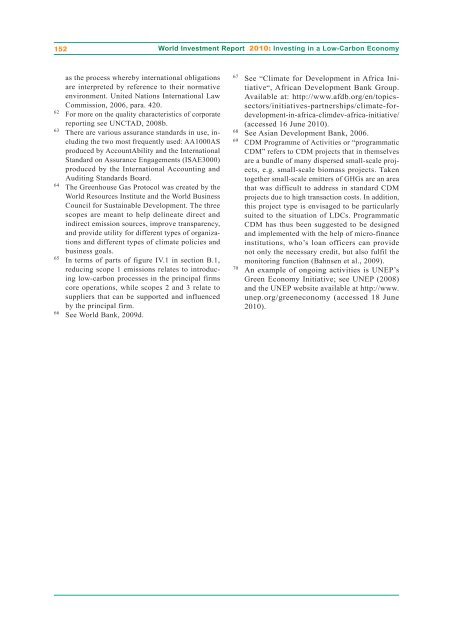UN World Investment Report 2010 - Office of Trade Negotiations
UN World Investment Report 2010 - Office of Trade Negotiations
UN World Investment Report 2010 - Office of Trade Negotiations
You also want an ePaper? Increase the reach of your titles
YUMPU automatically turns print PDFs into web optimized ePapers that Google loves.
152<br />
as the process whereby international obligations<br />
are interpreted by reference to their normative<br />
environment. United Nations International Law<br />
Commission, 2006, para. 420.<br />
62 For more on the quality characteristics <strong>of</strong> corporate<br />
reporting see <strong>UN</strong>CTAD, 2008b.<br />
63 There are various assurance standards in use, including<br />
the two most frequently used: AA1000AS<br />
produced by AccountAbility and the International<br />
Standard on Assurance Engagements (ISAE3000)<br />
produced by the International Accounting and<br />
Auditing Standards Board.<br />
64 The Greenhouse Gas Protocol was created by the<br />
<strong>World</strong> Resources Institute and the <strong>World</strong> Business<br />
Council for Sustainable Development. The three<br />
scopes are meant to help delineate direct and<br />
indirect emission sources, improve transparency,<br />
and provide utility for different types <strong>of</strong> organizations<br />
and different types <strong>of</strong> climate policies and<br />
business goals.<br />
65 In terms <strong>of</strong> parts <strong>of</strong> figure IV.1 in section B.1,<br />
reducing scope 1 emissions relates to introducing<br />
low-carbon processes in the principal firms<br />
core operations, while scopes 2 and 3 relate to<br />
suppliers that can be supported and influenced<br />
by the principal firm.<br />
66 See <strong>World</strong> Bank, 2009d.<br />
<strong>World</strong> <strong>Investment</strong> <strong>Report</strong> <strong>2010</strong>: Investing in a Low-Carbon Economy<br />
67 See “Climate for Development in Africa Initiative“,<br />
African Development Bank Group.<br />
Available at: http://www.afdb.org/en/topicssectors/initiatives-partnerships/climate-fordevelopment-in-africa-climdev-africa-initiative/<br />
(accessed 16 June <strong>2010</strong>).<br />
68 See Asian Development Bank, 2006.<br />
69 CDM Programme <strong>of</strong> Activities or “programmatic<br />
CDM” refers to CDM projects that in themselves<br />
are a bundle <strong>of</strong> many dispersed small-scale projects,<br />
e.g. small-scale biomass projects. Taken<br />
together small-scale emitters <strong>of</strong> GHGs are an area<br />
that was difficult to address in standard CDM<br />
projects due to high transaction costs. In addition,<br />
this project type is envisaged to be particularly<br />
suited to the situation <strong>of</strong> LDCs. Programmatic<br />
CDM has thus been suggested to be designed<br />
and implemented with the help <strong>of</strong> micro-finance<br />
institutions, who’s loan <strong>of</strong>ficers can provide<br />
not only the necessary credit, but also fulfil the<br />
monitoring function (Bahnsen et al., 2009).<br />
70 An example <strong>of</strong> ongoing activities is <strong>UN</strong>EP’s<br />
Green Economy Initiative; see <strong>UN</strong>EP (2008)<br />
and the <strong>UN</strong>EP website available at http://www.<br />
unep.org/greeneconomy (accessed 18 June<br />
<strong>2010</strong>).

















